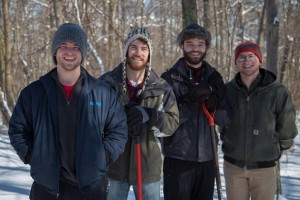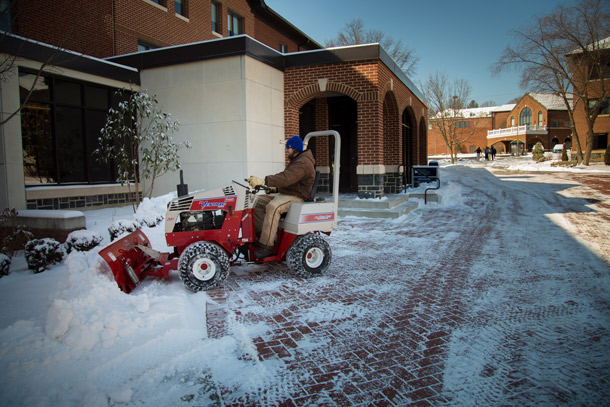The heavy snowfalls that hit Eastern Mennonite University in mid-February and promise to hit again this weekend may be welcomed by students sledding down the EMU hill, but they usually spell long hours with shovels and machines, sometimes overnight, for physical plant personnel to make paths and roadways safe for the rest of campus.
“When is it forecast to stop snowing? That’s one of the things I zero in on,” said Will Hairston, EMU grounds supervisor. Once he knows that, he can begin to develop his strategy for snow removal.
It’s a difficult task. “Even in a 1-inch snow there is a rush-time when they [the administration] want every walk and step cleared. Our campus is 100 acres. If you think about it, a house in Harrisonburg is located on approximately a quarter of an acre. So on campus, we might have 6 or 8 people clearing the equivalent of 400 houses,” he said.
No matter how much snow accumulates, EMU strives to open with minimal delays. However, the more complex the storm is, the more planning is necessary.
Every snowfall Hairston must consider: Is there enough salt? Will additional equipment be needed? Do I have enough manpower?

This week, due to shortages in his normal staff, Hairston hired temporary employees through student owned and operated BruCrew. “It is handy to have a temp agency that is familiar with campus and is made up of people we can trust – I was pleased with how that worked,” Hairston said.
Snow removal is expensive business. Last year, which was a bad year for snow and ice, physical plant budgeted $2,600 for snow removal, but ended up spending $8,300. This year they went toward the middle of those two numbers and budgeted $4,500. As of now, $3,400 of the $4,500 has been spent. “We will probably reach our budget,” noted Hairston.
Hairston isn’t worried. Although they have spent three quarters of their budget, much of that has gone toward the preventive measure of stocking supplies to last them the entire cold season, come what may. This is in direct response to a supply issue they encountered last year. As early as December of 2013 it became clear they might not be able to get more salt until the following summer. “That was a little frightening,” Hairston said.
On snowy days, Hairston has teams working around the clock. He assigns himself to some of the most undesirable shifts. “This past storm, I went home at 4 in the afternoon, went to sleep at 5, and came back in at 11:30 p.m.” When he arrived back at campus, he could tell the evening crew had just gone home because the truck was still warm and their clothes were in the dryer.

Night snow removal sounds like lonely, thankless work, but Hairston said it is just part of the job and that workers are able to stay connected through radios.
Besides, there are always humorous occurrences. “When you are running a snow blower, the landscape disappears so you have to make a mental map of where the sidewalks are. You can’t see anything underneath the snow and occasionally you might encounter something like a newspaper. Generally, the snow blower can handle the Daily News Record – but now, a Washington Post, that will stop it in its tracks.”

Kara, Thanks for the nice and timely article. The team isawesome! Looks like I left town just before the big one hit.It is still snowing lightly in PA but I expect to make it back Sunday evening.